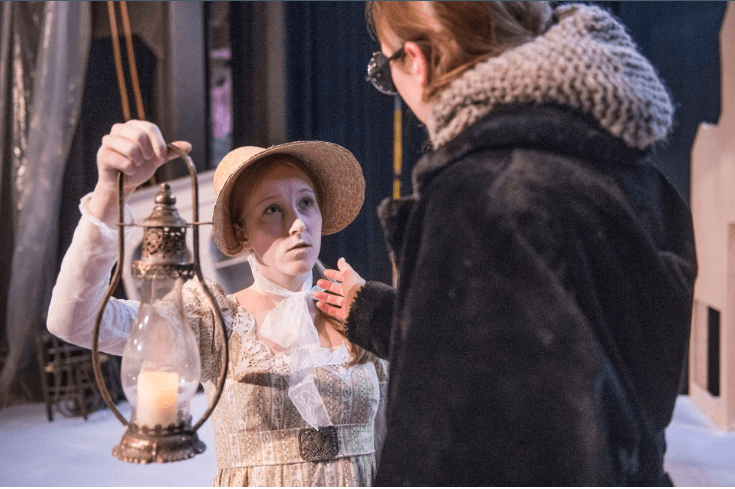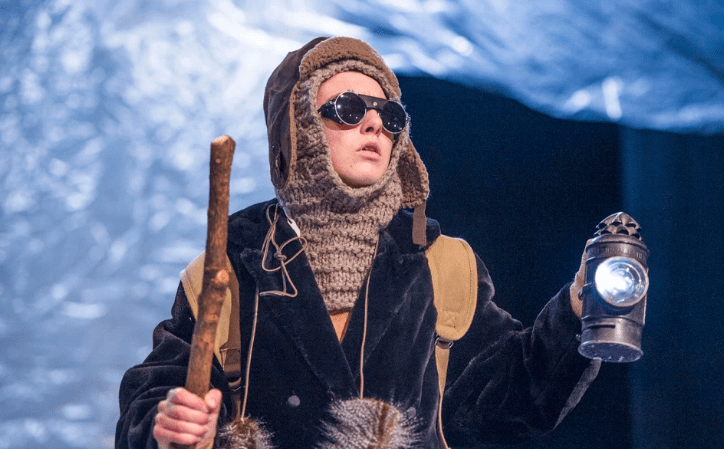201 years after Mary Shelley wrote Frankenstein, Whitman College students, faculty, and guest artists are bringing new life to the story with a production of Playing with Fire, an adaptation of the classic novel by playwright Barbara Field. The show follows the characters before and after the gothic tale takes place, pursuing the potential ethical limits of science. For this production, Harper Joy has sourced LA-based props designer and actor Ashley Flowers, and Portland, New York City-based sound designer Sharath Patel to craft a mesmerizing, multi-sensory world for the audience to enter. Below, Flowers and Patel describe professional aspects of their craft and moments of excitement about Harper Joy’s Production of Playing With Fire (After Frankenstein), opening next Thursday at @ 8 PM on Alexander Stage.
. . .
How would you say working as an actor influences your work as a props designer and vice versa?
AF. Because I have acting experience, I understand how important props are to an actor—how attached you become to a prop, how quickly you become attached to the prop. I’m a huge believer in getting the real prop into rehearsal as soon as possible, because there’s been times I’ve gotten a prop day one of tech, and was like, “oh, but this isn’t the basket I’ve been using!”….I’m also a huge believer in making the prop as realistic as possible. There’s a lot of people who are like “oh, but you’re not going to see it right up close.” But the actors are. And you’re not only building a prop for the audience, you’re also building it for the actor. Because it is their job to stay in this world and it is your job to help them stay in this world. So, if you gave them a foam carving of a roast beef and from afar it looks great, but up close it’s like, well this looks really bad…you’re gonna get distracted.
And then also vice versa as an actor I understand how long the process takes to build a prop, so I understand to be respectful. I know I’m not going to steal this prop at strike because someone just spent 70 hours to build it and that’s disrespectful to do.

Is there one rig or prop or effect that you’re really excited about with Playing With Fire, or would that be giving away too much?
AF. Well, I can’t say my favorite one…I think there’s going to be a lot of surprises for the audience and I’m mostly excited for that because I think they’re going to be shocked in a way they weren’t prepared to be shocked. I think this team is doing a really good job of not playing the whole “har har it’s Frankenstein,” but instead we’re giving it a new realistic humanity…which is really exciting and kind of a new take on it.
. . .
How would you define the role of sound design in a theatrical production?
SP. So sound designers are…definitely collaborators, but what people don’t know is that sound designers are in charge of all of the aural aspects of the show and by that I mean we have to think about not only the sound delivery system—how much noise it makes—but also the room itself…All of these are factors in modern American sound design because the average person can hear as low as 20 hertz and all the way up to 20,000 hertz, so anything below that 20 hertz is known as the subsonic range… We’re just scratching the surface of our understanding of playing around with subsonics.
[This is] something we’re actually doing with Playing with Fire. This idea of—I don’t want to say aurally manipulating—but basically aurally telegraphing the mood of the scene. Unlike the pretty music plays and it tells you how to feel—you know, very cinematic 2000s / 90s way of looking at things…You go see the rom-com and the funny music plays when Romantic Lead One is trying to get the attention of Romantic Lead Two and then you know they make the big dramatic moment happen, and the two players come together.
Theatrical sound design doesn’t have to be that way. We can be a lot more subtle in our attack and release… we can play around with subsonics and ultrasonics and things you can’t quite guarantee in a home theater system that we can give you in a live theatrical experience.
Is there a particular moment that you are excited about or proud of in Playing with Fire?
SP. This show truly is, in my opinion, kind of an exercise in devised silence…We are, I don’t want to say we’re flooding the audience’s ears, but my goal…is to find these moments of silence in the show that naturally exist and let them happen for a specific reason. It’s kind of like if you have an air conditioning unit going the entire time you’re in a room and it suddenly turns off and kinda just feels like the floor dropped out and suddenly you can hear everything—it’s something like that. And when I’m trying to figure out what those important moments are, you know, besides the end of the show, where else do we have that sort of aural texture…and how can I create aural landscapes to support certain scenes that don’t telegraph what’s happening?

How is the sound design in Playing With Fire different than other productions you’ve worked on?
SP. That is a fantastic question in that every show you do is a little bit different…With something like Playing with Fire, we exist kind of in, I believe the term they [the production team] were using is a memory warehouse, and I really latched on to this concept…they were talking about creating these visual sort of landscapes, so I took that information and decided to start creating aural landscapes, and what I did was take recordings of the first rehearsal, the actors’ voices, of the theater itself… and created aural landscapes to basically help support the storytelling.
Because, again, with Playing with Fire, the last thing you want to do is create some sort of aural experience that will really dictate to the audience what to feel…so basically I started creating aural landscapes to suggest feeling or support how they’re emoting or how they are performing on stage. In addition to that, I’ve just been having a lot of fun just because, I believe the phrase that Annaliese [Director] and Dan [Scenic Designer] used, was to scare the S-word out of the audience.
…You know, it’s all about creating a unique and integrated sound design for each production…One fun thing for the audience to listen for would be the sound of icebergs. Since the play begins at the top of the world, I got some amazing recordings (above and below the water) of the sounds of iceberg moving, rubbing against one another, as well as melting and cracking. I incorporated these sounds into obvious things like thunder but also low frequency soundscapes that are pervasive through the show…Just by happenstance, I was having a conversation with Annaliese in her office, and I had some really great recordings of people doing breath exercises and vocal distensions and we decided to pair that natural sort of breathing sound with the sort of mechanical…factory sound, and it created this wonderful marriage of the natural and the man-made, and it worked into a wonderful representation between Frankenstein and the creature.
….Finding a way to aurally represent these two characters in certain moments—it was just one of those really fun, collaborative processes where we are creating basically standing tones and aural environments out of the actors voice and all created naturally to play against this idea of man creating life.
Playing With Fire (After Frankenstein) opens October 24 @ 8PM in Alexander Stage, Harper Joy Theater. It runs Oct 24 – Oct 26 @ 8PM and Oct 26 – 27 @ 2 PM. Buy your tickets online HERE or at HJT Box Office open M – F, 12 – 4 PM or call (509) 527-5180.
Your point of view caught my eye and was very interesting. Thanks. I have a question for you.